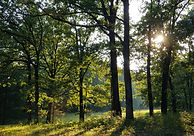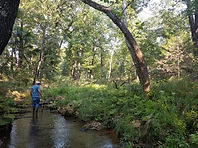
Chief Hope Historic Trail




Of all the events to take place in recorded county history, perhaps none demands one’s attention and careful ethical reflection more than the plight of Chief Opothleyahola and the Muskogee/Upper Creek people, as they experienced the horrifically brutal ordeal known as the “Trail of Blood on Ice” - which involves an area you can visit at the corner of 80th Road and Kanza Road, southwest of Yates Center.
When Opothleyahola, aka “Laughing Fox”/aka “Good Shouting Child,” and the Upper Creeks reached Fort Row between what is today Coyville and Fredonia, along the banks of the Verdigris River, they were dying by the hundreds due to hypothermia, starvation, and disease. They had abandoned their supplies while fleeing Confederate troops in Oklahoma Territory, and had no protection against the brutal Kansas winter. Chilling local legends include reports that the skeletons of native people and their animals, horses especially, littered both sides of the river for years afterward.
Finding no solace at Fort Row, the refugees journeyed north to Fort Belmont, along the banks of Big Sandy Creek, which was located southeast of where the “new” Yates Center Reservoir sits today. However, there were no adequate supplies here, either, save rancid meat that was unfit for human consumption, and a few blankets purchased by compassionate government officials.
In 1862, around 250 Creeks died in only the first two months at Belmont, and over one hundred people had limbs amputated. In one recurring heart-rending tale, a witness recalled seeing a little Creek boy with both feet having been removed following frostbite damage. Being familiar with these accounts, when one stands in the Big Sandy creekbed even today, one is quickly overwhelmed by emotion at the thought of such unparalleled suffering and abject deprivation.
Among those whose lives were lost at Belmont that hellish winter – and indeed, in Dante’s Inferno the lowest pit of hell is not a place of fire but ice – was Opothleyahola’s own daughter killed by tuberculosis. She is buried on a hill overlooking where the fort once stood, nestled in the middle of a circle of blackjack oak trees that have since grown up to surround her final resting place. It is reported that 2,000 people attended her funeral on an frigid icy day, but that nonetheless, garlands and wreaths of natural materials adorned the site.
Heartbroken, Chief Opothleyahola and many of the Upper Creeks carried on, pressing north once again, eventually coming to stop along the banks of the Neosho River between LeRoy and Neosho Falls. Given the timeline, it is possible that some of these refugees encountered another figure from county history, Major George Snow, who was an Indian Agent living in Neosho Falls at the time. After the Civil War ended (1865), many of the Creeks who had endured the “Trail of Blood on Ice” would return to Oklahoma Territory, the place where the whole grotesque ordeal had begun.
After his death in March 1863, at a Creek refugee camp in Osage County, Kansas, Opothleyahola’s body was returned to Fort Belmont and buried on the same hill overlooking the fort next to his daughter, beneath an earthen mound, perhaps along with his horse who died after being ridden to death in an attempt to return to Belmont as quickly as possible, when the Chief had been told the fort and his people were under siege.
Thanks to legislation developed and supported by historians from Woodson County, many of the areas described above, and marked along US-Highway 75, have been designated the Opothle Yahola Historic Trail. In 1995, this legislation was signed by Governor Bill Graves, who wrote of the Trail of Blood on Ice as having “belonged to a time that neither valued diversity nor difference,” while at the same time pointing out that “[though] we cannot change the past, we can [nonetheless] change how we view it.”